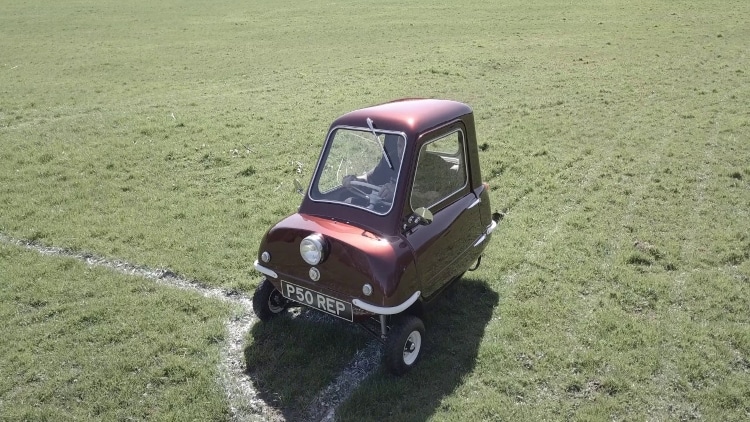World’s Smallest Car Looks Like a Toy and Is Now a Kit You Can Build Yourself

What's shorter than a Vespa and looks a bit like a Little Tikes Cozy Coupe? One of the rarest—and smallest—cars in the world.
The P.50 and Trident microcars were conceived in 1962 in the seaside town of Peel on the Isle of Man. Engineer Cyril Cannell, founder and owner of the company Peel Engineering, was fascinated by the then-new material fiberglass and began manufacturing boats from the reinforced lightweight material. In the early 1960s, he began experimenting with making cars from fiberglass and decided to try to produce an ultralight, ultra-compact vehicle—the ultimate bubble car. “The idea was simply to build a car that was able to take another person, as long as the two people weren't too large,” he said in a short documentary.
First came the P.50, and everything about it was tiny. This three-wheeled, one-seater model is just under four and a half feet long. After the P.50 was the Trident, a two-seater car with a clear, domed top.
The P.50 was the first car to be manufactured on the Isle of Man. Although it was a success on the mainland, it received mixed reactions on the island; despite the fact that it could squeeze into just about any parking spot, people just weren't sure about these minuscule cars and demand wasn't high enough to keep Peel Engineering in business. Only 50 original P.50s and 80 Tridents were built before production ceased four years later in 1966. Peel Engineering itself closed in 1974. Fewer than 30 original P.50s exist today, and those few often sell for over $170,000.
Still, there has always been a niche demand for the world's smallest car, and in 2010 the company P.50 Cars brought back the original designs, blending “60s style with modern reliability.” Most parts in this re-engineered version are reproductions of the originals and nearly indistinguishable from them—an accomplishment that took expert craftsman nearly a decade to achieve.
Car fans can buy the P.50 as a kit car, where every piece and component that goes into a factory build comes straight to the consumer. They can even choose from 12 different colors—the four originally offered by Peel, or six other additions, including “Capri Blue” and “British Racing Green.”
“Will I fit?” It's a common (and reasonable) question, so much so that it's answered on the FAQ page of P.50 Cars' website. The answer? “Yes, you probably will.” The tallest person to sit in one of the microcars was six feet and nine inches tall, and the largest person weighed over 300 pounds. However, the company did take into account the fact that today's average person is a bit taller than back in 1962 and increased the car's leg room by an extra two inches.
Watch the videos below to learn more about the origins of the world's smallest car and to see how it fares on the open road.
Developed by engineer Cyril Cannell in 1962, P.50 is the world's smallest car.
View this post on Instagram
View this post on Instagram
Originally made from fiberglass, the ultralight car is just under four and a half feet long and has three wheels.
View this post on Instagram
Though Cannell's company, Peel Engineering, stopped manufacturing the cars in 1966, P.50 Cars brought back the original designs. They are now available to buy factory-built, or as a kit to assemble yourself!
View this post on Instagram
Watch a replica P.5o in action:
Hear from Cannell himself about the microcars' story:
P.50 Cars: Website | Instagram | YouTube
h/t: [designboom]
All images via P.50 Cars.
Related Articles:
Volkswagen Upgrades Its Classic Van Into a Sustainable Electric Vehicle
This Futuristic Electric Car Is Designed To Clean the Surrounding Air Pollution
A Real Flying Car Just Completed Its First Inter-City Flight
Amazing Dad Builds Functional Mini Replica of $28M Rolls-Royce Car Out of Wood for His Son
READ: World’s Smallest Car Looks Like a Toy and Is Now a Kit You Can Build Yourself
0 Commentaires